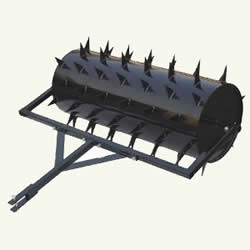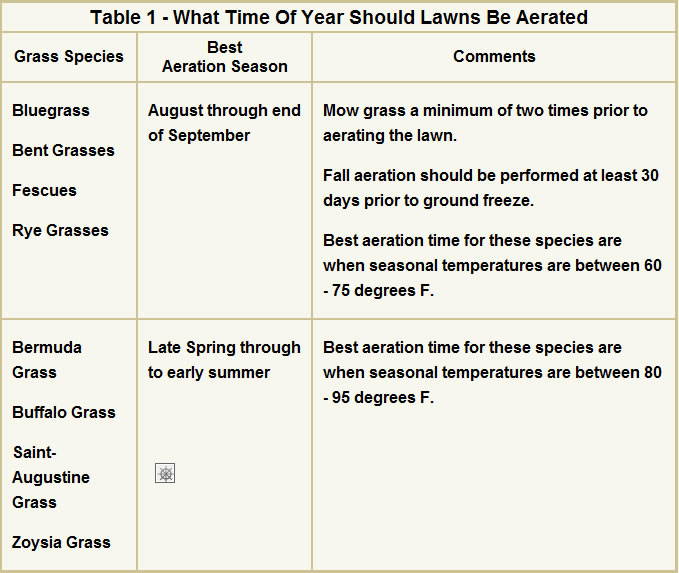
Figure 1 - Drum style spike aerator
Aerating your lawn will allow grass to thrive by allowing fertilizers and moisture to get to the root systems. Spreading tons of fertilizers on a lawn that is trying to grown in heavily compacted soil is not going to do its job. Proper lawn aeration will:
- Reduce and control the growth of thatch layer,
- Your grass will be better able to handle times of drought,
- Use less water,
- Provide space for new grass root growth,
- Increases the thickness of the grass,
- Improve the structure of the soil.
Every time someone walks on your lawn, it rains or snow, the top two to three inch layer of soil is heavily compacted. Compacted soil does not provide an area for grass root growth to take place. The more compact the soil the harder it is for grass roots to spread out and obtain the nutrients, oxygen and moisture that they need to for germination and healthy growth.
The harsher the climate, the more essential it is that the soil housing the grass root systems is loose enough to allow for healthy root growth and a place for the storage of nutrients, oxygen and moisture. Aerating your lawn helps to create a loose soil that can store all of the essentials necessary for hardy plant growth.
And if your landscaping is not flat, aeration provides the added benefits of preventing water run-off. It is not uncommon to see rolling landscape where the grass is barely growing on the slopes. One of the biggest causes of dying grass on rolling landscapes is that the water is running off the slope before it can penetrate the soil. Aerating the lawn will help to alleviate this problem.
Does Your Lawn Need Aeration?
Knowing when to aerate your lawn is as important as aerating it in the first place. There are some common signs of compacted soil – which of course means that your lawn needs to be aerated.
- Grass is brown in areas where people walk or children play,
- You have puddles of water remaining on the lawn after your water or after a rain shower,
- Instead of soaking into the soil when watering, the water runs off the soil,
- Areas of your lawn are dry no matter how much water you apply to them,
Testing The Compaction Of Your Soil:
A quick an inexpensive test to see how compacted your soil is, can be accomplished with a screwdriver with a 6 inch long shaft. You should be able to push the blade of the screwdriver, up to the screwdriver handle, into the ground with little effort. If you can, your soil is not compacted, if you cannot then you have a soil compaction problem and your lawn should be aerated.
Frequency Of Lawn Aeration:
How often you need to aerate your lawn is subject to a number of factors. Soil that compacts easily, such as clay, may need to be aerated twice a year. While soils that have a large percentage of sand in them may only need aeration every three years. Heavy traffic areas, such as areas where children play, lawn seating areas and pathways will compact soil. It is highly likely that some areas of your lawn will compact at a higher rate than others and hence will need to be aerated more often.
It is best to do the previously described screwdriver test every spring and fall to determine if the soil has been compacted. Be sure to check the high traffic areas and any other area that may be showing signs the signs of soil compaction that were previously described.
What Time Of Year Should Lawns Be Aerated?
Aeration should be undertaken at the peak of the season for your specific species of grass. Table 1 shows a number of different grass species and the best times for aeration.

Lawn aerators are available at most garden centers. You can buy small hand aerators or larger self propelled aerators. You can also rent aerators from most of the larger equipment rental companies or you can hire a local aeration service.
Aerator Types:
As with most tools for home projects, there are tools that do a professional job and there are tools that are less expensive and in some cases do not really do the job that they are supposed to do.
There are basically two types of aerators:
- Aerators that remove a plug of earth from the ground – core aerators
.
- Aerators that punch a hole in the ground – spike aerators
.
Spike Aerators:
Spike style aerators come in a variety of shapes and sizes. A spike aerator will have a number of spikes that that penetrate the turf or sod with the intent of making holes in the soil.
By driving a spike into the soil, a spike aerator creates a hole, but when it creates the hole it actually compacts the earth around and below the spike. This only makes sense, as the earth where the hole is now, had to go somewhere.
In many cases the spikes are not long enough to actually penetrate below the turf and hence they are all but useless.
Core Aerators:
A core aerator removes a plug of earth from the soil, hence it does not compact the soil in the same manner as a spike aerator.
The hole that is left provides a nutrient shaft to the routes of the soil and allows the grass roots to spread out and grow deeper.
Note: Core aerators are the recommended tool for aerating a lawn.
